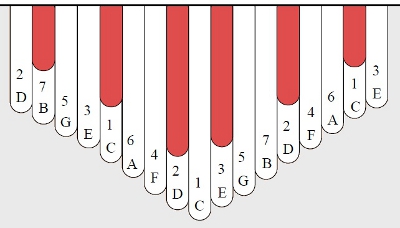The 17-Note Kalimba in C is a great introductory kalimba. In this post you’ll read about this new instrument and how it can be the door into the world of the modern kalimba.
The heart-shaped sound hole of the 17-Note Kalimba in C (made in China for Kalimba Magic) represents my love for the kalimba (and I hope it will be the same for you!). Depending on how you look at it, the wood-etched shadow of the heart echoes the stylized forms of a dolphin and a bird, representing wild and free life. The wood-etched stars represent the hope for a sparkly, sparkly future for all people and for all beings on our earth, and for your kalimba playing as well!
The 17-Note has some of its tines painted. Learning why kalimba tines are painted, and how these marked tines are utilized, will give you access to the extensive body of kalimba instructional materials that I have created over the last 14 years.
Painted tines help you match your kalimba’s tine layout to the kalimba tablature, which is an invention of my own design and makes sharing kalimba music possible in ways other than just by hearing it. The 17-Note in C (just like the Bb Treble) is set up and painted to read Alto tablature. Which means that any of a wide selection of Alto books and downloads can profitably be used with this kalimba.
It doesn’t matter what key the kalimba is in – what matters is the painted tine patterns relative to the “degree of the scale” – those note NUMBERS you see in the graphic below. Kalimbas in any key, set up in this way, can all read the Alto tablature.
 Here are some details of tine-painting rationale to help you begin to understand it. Two of the three C (remember, C is the root) notes on this kalimba are on painted tines, and the low C is in between two painted tines. These are good targets to aim for, as C is the most stable note on which to start or end when playing in the key of C.
Here are some details of tine-painting rationale to help you begin to understand it. Two of the three C (remember, C is the root) notes on this kalimba are on painted tines, and the low C is in between two painted tines. These are good targets to aim for, as C is the most stable note on which to start or end when playing in the key of C.
For another take on understanding the value of painted tines, look at the lowest (longest) left-side painted tine. It is D, down near the center. If you were playing that painted D tine and wanted to go one step higher in the scale, that would be E, the painted tine just opposite the D. Similarly, if you were playing the middle C in the middle of the left side, a painted tine, one step higher in the scale is D, the painted tine on the opposite side. And last, the high B on the far left? One step higher on the scale is the high C, also painted, on the right side. These placements will gradually become a part of your mind’s experience of this kalimba, and you will come to instinctively know the positions of the painted tines and their neighbors.
Also, the painted tines help you locate yourself in general. Just about any particular tine will be a painted tine, or one above (shorter than) a painted tine, or one below (longer than) a painted tine. And this helps you interface left and right as well. The low F on the lower left? It is one tine shorter than the painted D. To go one note higher than F in the scale, go across and find the tine one shorter than the painted E tine – and there it is, the G!
To summarize, the painted tines help you target the root notes (when playing in C major), help you interface left and right, and help give you a landmark for any tine you might need to remember in any song. And one more important reason to get your 17-Note kalimba with tines painted our way: if your tines are painted another way, you won’t be able to use our books for the 17-Note in C, the 10-Note in C, or the Alto kalimba.
 We offer these kalimbas with their six painted tines in a variety of color choices: red, blue, green, yellow, white, or unpainted. If you get your kalimba with unpainted tines, you can always mark them yourself with a Sharpie marker (which will come off with alcohol wipes).
We offer these kalimbas with their six painted tines in a variety of color choices: red, blue, green, yellow, white, or unpainted. If you get your kalimba with unpainted tines, you can always mark them yourself with a Sharpie marker (which will come off with alcohol wipes).
The 17-Note Heart Kalimba has exactly the same footprint as the Hugh Tracey Kalimba – that is, it is a copy of the Treble, right down to the precise size of the resonant box. However, the wood on the Heart kalimba is significantly thinner and the kalimba is much lighter in weight than the Hugh Tracey Treble. Though this makes it easier to hold, the thinner wood indicates the Heart kalimba may fare less well if you stepped on it or fell while holding it. Do play safely with your kalimbas!
Anyway, the 17-Note Heart kalimbas have a lovely voice and feel smooth and sweet in the hands. The video speaks for itself.


Sign up for our newsletter and free resources with your email address:
We pinky promise not to spam you and to only send good stuff.
 Christmas in July 2025
Christmas in July 2025 Patriotic and American Music for Kalimba
Patriotic and American Music for Kalimba